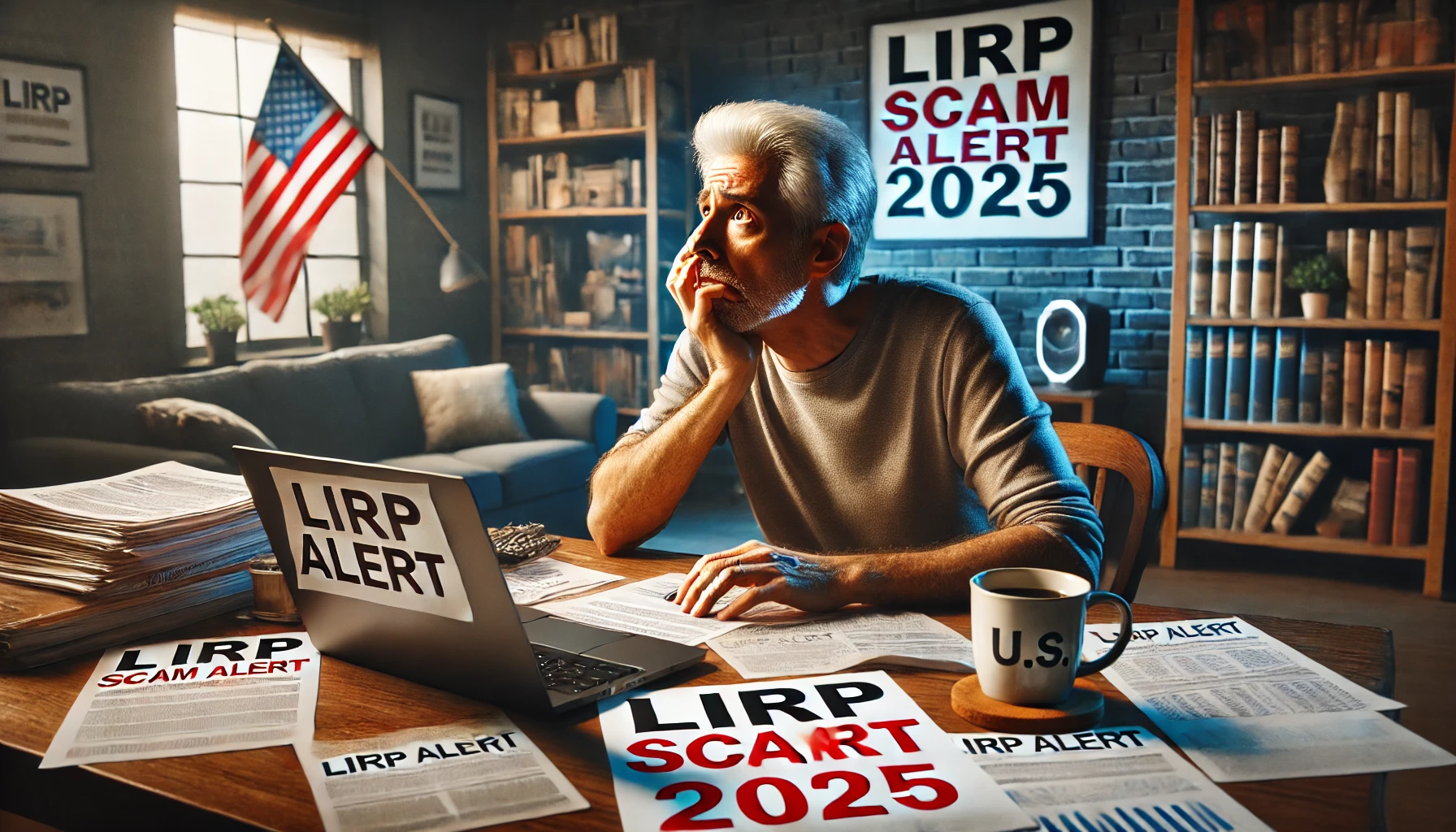Contents
Stay ahead with this LIRP scam alert 2025! Learn how to protect retirement plans in the U.S. from fraud, spot LIRP scams in the U.S. 2025, and secure your financial future with expert tips, red flags, and a chart comparing legit vs. scam LIRPs.
Introduction on LIRP Scam Alert 2025
In 2025, U.S. retirees and savers lost over $3 billion to financial scams, with LIRP scam alert 2025 United States trending as a major concern for those seeking secure retirement options. A Life Insurance Retirement Plan (LIRP) can be a powerful tool for tax-free retirement income, but its growing popularity has made it a prime target for fraudsters. Whether you’re a retiree in Florida or a young saver in California planning for the future, understanding what are LIRP scams 2025 U.S. and how to avoid them is crucial to safeguarding your financial future.
A LIRP is a permanent life insurance policy with a cash value component that allows you to access tax-free funds for retirement. It’s often marketed as a safe alternative to traditional retirement plans like IRAs or 401(k)s, offering protection against market volatility and tax advantages. However, the complexity of LIRPs makes them ripe for exploitation by scammers, especially with AI-enhanced LIRP scams in the U.S. 2025 on the rise. These scams often target unsuspecting Americans through phishing emails, fake websites, and social media ads, promising “guaranteed returns” that never materialize.
This guide will help you navigate the LIRP scam alert 2025 United States landscape by explaining how LIRPs work, identifying LIRP fraud warning signs 2025 U.S., and providing actionable steps to protect retirement plans from LIRP scams 2025. From spotting red flags to verifying advisors, we’ll equip you with the tools to secure your retirement savings. Let’s dive into understanding LIRPs and how to stay safe in 2025.
RELATED: Retirement Planning: Steps, Tools, and Strategies for 2024
Understanding LIRPs and Their Appeal in the U.S.
What is a LIRP?
A LIRP for U.S. retirement—short for Life Insurance Retirement Plan—is a permanent life insurance policy designed to double as a retirement savings vehicle. Unlike term life insurance, a LIRP (typically a whole life or indexed universal life policy) builds cash value over time, which you can access through tax-free loans or withdrawals during retirement. According to Aflac, LIRPs are ideal for Americans who’ve maxed out contributions to IRAs or 401(k)s and seek additional tax-advantaged savings.
Here’s how it works: You pay premiums into the policy, a portion of which goes toward the death benefit, while the rest accumulates in a cash value account. Over time, this cash value grows, either at a fixed rate (whole life) or tied to market indices (indexed universal life), as explained by InsuranceGeek. When you retire, you can borrow against the cash value tax-free, providing a steady income stream without the market risks of stocks or the tax burdens of traditional retirement accounts.
Benefits for U.S. Savers
The LIRP benefits in the U.S. are significant, especially for those worried about taxes and market volatility. First, LIRPs offer tax-free withdrawals, a major draw for Americans facing potential tax hikes as the national debt climbs to $36 trillion in 2025. Second, they provide downside protection—indexed universal life LIRPs, for instance, cap losses during market downturns while allowing gains tied to indices like the S&P 500, as noted by InsuranceandEstates [Web ID: 2]. Third, LIRPs offer flexibility: you can adjust premiums and access funds as needed, making them appealing for early retirees or high earners.
Who Uses LIRPs?
LIRPs are popular among diverse U.S. demographics. High earners who’ve maxed out 401(k) contributions often turn to LIRPs for additional tax-advantaged growth, according to Citizens Bank [Web ID: 3]. Early retirees in states like Florida and Texas use LIRPs to supplement income without tapping Social Security too early. Families with dependents also value the death benefit, ensuring financial security for loved ones while saving for retirement.
U.S. Context
In the U.S., LIRP for U.S. retirement planning has gained traction amid economic uncertainty. With rising national debt and fears of future tax increases, Americans are seeking alternatives to traditional retirement plans. LIRPs provide a hedge against these risks, offering tax-free income and market protection. However, their complexity makes them a target for scams, which we’ll explore next.
The Rise of LIRP Scams in 2025
Modern Scam Tactics
The LIRP scams 2025 landscape has evolved, with fraudsters leveraging advanced technology to target U.S. savers. AI-enhanced LIRP scams in the U.S. 2025 are a growing threat, using machine learning to craft convincing phishing emails and fake websites that mimic legitimate insurers. These scams often start with unsolicited contact via email, social media, or phone calls, promising “risk-free” retirement solutions—a tactic warned against by Investor.gov.
Common LIRP Scams in the U.S.
Several LIRP scam examples for U.S. retirees 2025 illustrate the dangers. First, fake advisors promise “guaranteed returns,” a red flag since no financial product can guarantee gains without risk. Second, scammers sell misleading policies, such as variable universal life policies marketed as “risk-free,” which can lead to unexpected losses, as cautioned by InsuranceandEstates. Third, overfunding scams push policyholders to pay excessive premiums, turning the policy into a Modified Endowment Contract (MEC) with unintended tax consequences, a risk highlighted by ThinkAdvisor.
Why LIRPs Are Vulnerable
LIRPs are vulnerable to fraud due to their complexity. High fees, lack of transparency, and the need for proper structuring (e.g., avoiding MEC status) make them easy to exploit. Scammers prey on Americans’ desire for tax-free income, especially in a climate of economic uncertainty, by offering deals that sound too good to be true.
Case Study
Consider Jane, a retired teacher in Florida. In 2025, she received a phishing email promising a “tax-free LIRP” with “guaranteed returns.” The email linked to a fake website mimicking a well-known insurer. Jane invested $50,000, only to lose it all when the scammer disappeared. Her story underscores the need to understand how LIRP scams work in the U.S. 2025 and take proactive steps to protect your savings.
5 Red Flags of LIRP Scams to Watch For
Identifying LIRP scam red flags for U.S. retirees 2025 is the first step to staying safe. Here are five warning signs to watch for, paired with an infographic for easy reference.
Red Flag 1: Unsolicited Contact
Scammers often initiate contact through unsolicited emails, calls, or social media ads. If someone you don’t know reaches out about a LIRP, be wary—it’s a common tactic, as noted by Investor.gov
Red Flag 2: Guaranteed Returns
No financial product can guarantee returns without risk. If a LIRP advisor promises “guaranteed” gains, it’s a major LIRP fraud warning sign 2025 U.S., according to Forbes.
Red Flag 3: Pressure to Act Quickly
Scammers often pressure you to invest immediately, claiming the “deal” won’t last. Legitimate advisors give you time to research and decide.
Red Flag 4: Fake Advisors or Websites
Fraudsters may pose as licensed advisors or create fake websites mimicking insurers. Always verify credentials through U.S. regulatory bodies like FINRA or the SEC.
Red Flag 5: Hidden Fees or MEC Risks
Lack of transparency about fees or the risk of overfunding (leading to MEC status) is a red flag. Scammers may hide these details to lure you in, as warned by ThinkAdvisor.
Infographic: 5 Red Flags of LIRP Scams
[Insert Infographic: “5 Red Flags of LIRP Scams” with icons—phone for unsolicited contact, dollar sign for hidden fees, etc. Alt text: “Infographic of LIRP scam red flags for U.S. retirement planning 2025.”]
Knowing how to spot LIRP scams in the U.S. 2025 can save you from financial loss. Next, we’ll explore how to protect yourself.
How to Protect Yourself from LIRP Scams in the U.S.
Protecting your retirement savings starts with proactive steps. Here are five LIRP scam prevention tips for U.S. savers 2025, along with a chart comparing legit and scam LIRPs.
Tip 1: Verify Advisors
Always check an advisor’s credentials through U.S. regulatory bodies like the SEC or FINRA. How to verify LIRP advisors in the U.S. 2025 is simple: use FINRA’s BrokerCheck tool to confirm licensing and history, as recommended by Investor.gov [Web ID: 14].
Tip 2: Research Policies Thoroughly
Understand the LIRP structure before investing. Whole life LIRPs offer stability, while indexed universal life ties growth to market indices, as explained by InsuranceandEstates. Compare policies from reputable companies like Allianz, as suggested by InsuranceGeek.
Tip 3: Avoid Unsolicited Offers
Delete suspicious emails or messages claiming to offer “risk-free” LIRPs. This is a key step to avoid LIRP phishing scams in the U.S. 2025, a growing threat in the digital age.
Tip 4: Use Secure Platforms
Only access financial services through official websites, not links from search engines or emails. This ensures you’re dealing with legitimate providers.
Tip 5: Educate Yourself
Learn about LIRPs and scams through credible U.S. resources like IRS guidelines or FINRA alerts. Knowledge is your best defense against fraud.
U.S. Context
In the U.S., consider joining local financial literacy workshops or online communities like Reddit’s r/personalfinance for support. These platforms can help you stay informed about protect from LIRP scams strategies.
Chart: Legit LIRP vs. Scam LIRP
[Insert Chart: “Legit LIRP vs. Scam LIRP” comparing transparency, advisor credentials, and guarantees. Alt text: “Chart comparing legit vs. scam LIRPs for U.S. savers 2025.”]
| Feature | Legit LIRP | Scam LIRP |
| Transparency | Clear fees, MEC risks explained | Hidden fees, vague terms |
| Advisor Credentials | Licensed, verifiable via FINRA | Unverified, unsolicited contact |
| Guarantees | Realistic growth projections | “Guaranteed” returns, no risk |
These steps will help you avoid LIRP fraud in the U.S. 2025 and secure your retirement plans.
Conclusion on LIRP Scam Alert 2025
Navigating the LIRP scam alert 2025 United States landscape requires vigilance, especially with the rise of AI-enhanced LIRP scams in the U.S. 2025. While LIRPs offer tax-free income and market protection, their complexity makes them a target for fraudsters. By understanding LIRP scam red flags for U.S. retirees 2025, such as unsolicited contact and hidden fees, and following our LIRP scam prevention tips for U.S. savers 2025, you can protect retirement plans from LIRP scams 2025 and secure your financial future.
Take action today: share this article with friends, join a U.S. financial literacy group like r/personalfinance on Reddit, and follow us on social media for more tips on financial security for U.S. retirees. Don’t let LIRP scams derail your retirement dreams—stay informed and secure your future in 2025.
FAQ About LIRP Scam Alert 2025.
Q 1: What is a LIRP and why is it popular in the U.S.?
A LIRP for U.S. retirement is a permanent life insurance policy that builds cash value for tax-free retirement income. It’s popular in the U.S. due to tax advantages, market protection, and flexibility, especially with rising national debt concerns in 2025.
Q 2: What are the latest LIRP scams in 2025?
The LIRP scams 2025 include AI-enhanced phishing, fake advisors promising “guaranteed returns,” and overfunding scams leading to MEC status. These scams target U.S. savers through emails and social media.
Q 3: How can I spot LIRP scams in the U.S. 2025?
To spot LIRP scams in the U.S. 2025, look for unsolicited contact, guaranteed returns, pressure to act quickly, fake advisors, and hidden fees. Our infographic on red flags provides a visual guide.
Q 4: How can I protect my retirement plans from LIRP scams?
You can protect retirement plans from LIRP scams 2025 by verifying advisors, researching policies, avoiding unsolicited offers, using secure platforms, and educating yourself through U.S. resources like FINRA.
Q 5: Are LIRPs a good option for U.S. retirement 2025?
Are LIRPs a good option for U.S. retirement 2025 depends on your goals. They offer tax-free income and market protection but come with scam risks. Research thoroughly to ensure they fit your plan.
Q 6: What are LIRP scams 2025 U.S. retirees should know?
What are LIRP scams 2025 U.S. retirees should know include fake advisors, misleading policies, and phishing scams. Retirees in states like Florida are especially vulnerable to these tactics.
Q 7: What are LIRP fraud warning signs in 2025 for U.S. savers?
LIRP fraud warning signs 2025 U.S. include unsolicited contact, unrealistic promises, and lack of transparency. Always verify advisors and policies before investing.
Q 8: How do LIRP scams work in the U.S. in 2025?
How LIRP scams work in the U.S. 2025 involves scammers using AI to create fake websites, offering “risk-free” LIRPs, and pressuring victims to overfund policies, leading to financial loss.
Q 9: Can you share LIRP scam examples for U.S. retirees in 2025?
LIRP scam examples for U.S. retirees 2025 include a Florida teacher losing $50,000 to a phishing email promising a “tax-free LIRP.” Scammers often target retirees with promises of guaranteed returns.
Q 10: How to avoid LIRP fraud in the U.S. in 2025?
To avoid LIRP fraud in the U.S. 2025, verify advisors through FINRA, research policies, delete unsolicited offers, use secure platforms, and educate yourself about scam tactics.
Q 11: How can I protect retirement plans from LIRP scams in 2025?
Protect retirement plans from LIRP scams 2025 by following our five tips: verify advisors, research thoroughly, avoid unsolicited offers, use secure platforms, and stay informed through U.S. resources.
Q 12: What are LIRP scam prevention tips for U.S. savers in 2025?
LIRP scam prevention tips for U.S. savers 2025 include checking advisor credentials, understanding policy terms, avoiding phishing scams, using official websites, and joining financial literacy communities.
Q 13: How to spot LIRP scams in the U.S. in 2025?
Spot LIRP scams in the U.S. 2025 by watching for red flags like unsolicited contact, guaranteed returns, and fake websites. Our infographic highlights these warning signs in detail.
Q 14: How to verify LIRP advisors in the U.S. in 2025?
How to verify LIRP advisors in the U.S. 2025 involves using FINRA’s BrokerCheck tool to confirm licensing and history. Always ensure advisors are registered with U.S. regulatory bodies.
Q 15: What are LIRP vs IRA scam risks in the U.S. in 2025?
LIRP vs IRA scam risks in the U.S. 2025 show LIRPs are more vulnerable due to complexity and hidden fees, while IRAs face risks like phishing for account details. Research both thoroughly.
Q 16: How does LIRP vs 401k fraud protection compare in the U.S. 2025?
LIRP vs 401k fraud protection U.S. 2025 differs as 401(k)s have stricter regulations, while LIRPs require more diligence to avoid scams. Verify advisors for both to stay safe.
Q 17: Is a LIRP safe from scams in the U.S. in 2025?
Is a LIRP safe from scams in the U.S. 2025 depends on your precautions. LIRPs can be safe if you verify advisors and avoid unsolicited offers, but they’re vulnerable to fraud without due diligence.
Q 18: What are LIRP tax advantages and scam risks in 2025 U.S.?
LIRP tax advantages and scam risks 2025 U.S. include tax-free withdrawals but also risks like overfunding scams leading to MEC status. Balance benefits with caution to avoid fraud.
Q 19: What are the best LIRP companies to avoid scams in the U.S. 2025?
Best LIRP companies to avoid scams U.S. 2025 include reputable providers like Allianz, known for transparency. Always verify through official channels to ensure legitimacy.
Q 20: How can I avoid LIRP phishing scams in the U.S. in 2025?
Avoid LIRP phishing scams in the U.S. 2025 by deleting suspicious emails, not clicking unknown links, and accessing financial services only through official websites. Stay vigilant to protect your savings.


